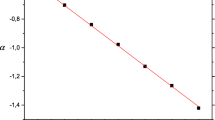Abstract
Molecularly imprinted composite membranes for selective binding of erythromycin were synthesized by UV initiated photo-copolymerization using polysulfone ultrafiltration (PSF) membranes as porous supports. The thin imprinted layers deposited on the surface of the support membranes were formed by copolymerization of acrylic acid (AA) as functional monomer and ethylene glycol dimethacrylate (EGDMA) as cross-linker in the presence of erythromycin as template molecule in acetonitrile solution. Fourier transform infrared spectroscopy (FT-IR) was used to study the binding mechanism between the imprinted sites and the template. Scanning electron microscope (SEM) was utilized to visualize surface and cross-sections of membranes to gain better understanding in the analysis of imprinted layers deposited on PSF support membranes. The modification degrees for imprinted and nonimprinted membranes are 2.04 and 2.15 mg/cm2, respectively. Static equilibrium binding and recognition properties of the imprinted and nonimprinted membranes to erythromycin (EM) and its analogue roxithromycin (RM) in aqueous system were tested. The results showed that saturated binding capacity of imprinted membranes to erythromycin was about 0.185 mg/cm2, nearly eight times that of nonimprinted ones, and the selectivity factor of αEM/RM was 3.24. The results of this study implied that the synthesized molecularly imprinted composite membranes could be used as selective separation materials for erythromycin enrichment from water.
Similar content being viewed by others
References
Baker R W (2004). Membrane Technology and Applications, 2nd ed. Chichester: Wiley
Golet E M, Alder A C, Hartmann A, Ternes TA, Giger W (2001). Trace determination of fluoroquinolone antibacterial agents in urban wastewater by solid-phase extraction and liquid chromatography with fluorescence detection. Anal Chem, 73(15): 3632–3638
Haupt K, Mosbach K (2000). Molecularly imprinted polymers and their use in biomimetic sensors. Chem Rev, 100(7): 2495–2504
Hirsch R, Ternes T A, Haberer K, Mehlich A, Ballwanz F, Kratz K L (1998). Determination of antibiotics in different water compartments via liquid chromatography-electrospray tandem mass spectrometry. J Chromatogr A, 815(2): 213–223
Ho W S W, Sirkar K K (1992). Membrane Handbook. New York: WNR
Klein E (2000). Affinity membranes: a 10-year review. J Membr Sci, 179(1–2): 1–27
Kobayashi T, Fukaya T, Abe M, Fujii N (2002). Phase inversion molecular imprinting by using template copolymers for high substrate recognition. Langmuir, 18(7): 2866–2872
Leal C, Codony R, Compano R, Granados M, Prat M D (2001). Determination of macrolide antibiotics by liquid chromatography. J Chromatogr A, 910(2): 285–290
Mosbach K, Haupt K (1998). Some new developments and challenges in noncovalent molecular imprinting technology. J Mol Recogn, 11(1–6): 62–68
Piletsky S A, Dubei I Y, Fedroyak D M, Kukhar V P (1990). Sustrate-selective polymeric membranes: selective transfer of nucleic acid components. Biopolym Kletka, 6: 55–58
Piletsky S A, Panasyuk T L, Piletskaya E V, et al (1999). Receptor and transport properties of imprinted polymer membranes: a review. J Membr Sci, 157(2): 263–278
Piletsky S A, Piletskaya E V, Panasyuk T L, El’skaya A V, Levi R, Karube I, Wulff G (1998). Imprinted membranes for sensor technology: opposite behavior of covalently and noncovalently imprinted membranes. Macromolecules, 31(7): 2137–2140
Ramamoorthy M, Ulbricht M (2003). Molecular imprinting of cellulose acetate-sulfonated polysulfone blend membranes for Rhodamine B by phase inversion technique. J Membr Sci, 217(1): 207–214
Richard J A (2004). Molecularly imprinted polymers in pseudoimmunoassay. J Chromatogr B, 804(1): 151–165
Sanbe H, Hosaka K, Haginaka J (2003). Preparation of uniformly sized molecularly imprinted polymers for phenolic compounds and their application to the assay of bisphenol A in river water. Anal Sci, 19(5): 715–719
Sellergren B (2001). Imprinted chiral stationary phases in high-performance liquid chromatography. J Chromatogr A, 906(1–2): 227–252
Sergeeva TA, Piletsky S A, Piletskaya E V, Brovko O O, Karabanova L V, Sergeeva L M, El’skaya AV, Turner A P (2003). In situ formation of porous molecularly imprinted polymer membranes. Macromolecules, 36(19): 7352–7357
Suedee R, Srichana T, Chuchome T, Kongmark U (2004). Use of molecularly imprinted polymers from a mixture of tetracycline and its degradation products to produce affinity membranes for the removal of tetracycline from water. J Chromatogr B, 811(2): 191–200
Takeda K, Kobayashi T (2005). Bisphenol a imprinted polymer adsorbents with selective recognition and binding characteristics. Sci Technol Adv Mater, 6: 165–171
Ulbricht M (2004). Membrane separations using molecularly imprinted polymers. J Chromatogr B, 804(1): 113–125
Ulbricht M (2006). Advanced functional polymer membranes. Polymer, 47(7): 2217–2262
Wang H Y, Kobayashi T, Fujii N (1996). Molecular imprint membranes prepared by the phase inversion precipitation technique. Langmuir, 12: 4850–4856
Wulff G, Sarhan A (1972). Use of polymers with enzyme-analogous structures for the resolution of racemates. Angew Chem Int Ed Eng, 11: 341–343
Wullf G (2002). Enzyme-like catalysis by molecularly imprinted polymers. Chem Rev, 102(1): 1–28
Yang H H, Zhang S Q, Yang W, Chen X L, Zhuang Z X, Xu J G, Wang X R (2004). Molecularly imprinted sol-gel nanotubes membrane for biochemical separations. J Am Chem Soc, 126(13): 4054–4055
Author information
Authors and Affiliations
Corresponding author
Rights and permissions
About this article
Cite this article
Yu, J., Hu, X., Li, D. et al. Thin layer molecularly imprinted composite membranes for selective separation of erythromycin from water. Front. Earth Sci. China 3, 480–489 (2009). https://doi.org/10.1007/s11707-009-0055-z
Received:
Accepted:
Published:
Issue Date:
DOI: https://doi.org/10.1007/s11707-009-0055-z



